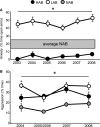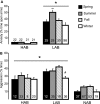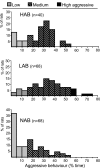Aggression and anxiety: social context and neurobiological links
- PMID: 20407578
- PMCID: PMC2854527
- DOI: 10.3389/fnbeh.2010.00012
Aggression and anxiety: social context and neurobiological links
Abstract
Psychopathologies such as anxiety- and depression-related disorders are often characterized by impaired social behaviours including excessive aggression and violence. Excessive aggression and violence likely develop as a consequence of generally disturbed emotional regulation, such as abnormally high or low levels of anxiety. This suggests an overlap between brain circuitries and neurochemical systems regulating aggression and anxiety. In this review, we will discuss different forms of male aggression, rodent models of excessive aggression, and neurobiological mechanisms underlying male aggression in the context of anxiety. We will summarize our attempts to establish an animal model of high and abnormal aggression using rats selected for high (HAB) vs. low (LAB) anxiety-related behaviour. Briefly, male LAB rats and, to a lesser extent, male HAB rats show high and abnormal forms of aggression compared with non-selected (NAB) rats, making them a suitable animal model for studying excessive aggression in the context of extremes in innate anxiety. In addition, we will discuss differences in the activity of the hypothalamic-pituitary-adrenal axis, brain arginine vasopressin, and the serotonin systems, among others, which contribute to the distinct behavioural phenotypes related to aggression and anxiety. Further investigation of the neurobiological systems in animals with distinct anxiety phenotypes might provide valuable information about the link between excessive aggression and disturbed emotional regulation, which is essential for understanding the social and emotional deficits that are characteristic of many human psychiatric disorders.
Keywords: HAB rats; HPA axis; LAB rats; abnormal aggression; serotonin; trait anxiety; vasopressin; violence.
Figures





References
LinkOut - more resources
Full Text Sources
Other Literature Sources
Miscellaneous

